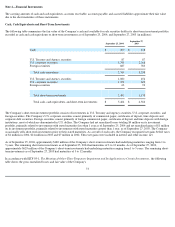Apple 2004 Annual Report Download - page 73
Download and view the complete annual report
Please find page 73 of the 2004 Apple annual report below. You can navigate through the pages in the report by either clicking on the pages listed below, or by using the keyword search tool below to find specific information within the annual report.
Shipping Costs
The Company's shipping and handling costs are included in cost of sales for all periods presented.
Warranty Expense
The Company provides currently for the estimated cost for product warranties at the time the related revenue is recognized.
Research and Development
Research and development costs are expensed as incurred. Development costs of computer software to be sold, leased or otherwise marketed are
subject to capitalization beginning when a product's technological feasibility has been established and ending when a product is available for
general release to customers pursuant to SFAS No. 86, Computer Software to be Sold, Leased, or Otherwise Marketed . In most instances, the
Company's products are released soon after technological feasibility has been established. Therefore, costs incurred subsequent to achievement
of technological feasibility are usually not significant, and generally all software development costs have been expensed.
During the fourth quarter of 2004, the Company incurred substantial development costs associated with the development of Mac OS X version
10.4 (code-named "Tiger"), which enhances the features and functionality of the previous version of Mac OS X, subsequent to achievement of
technological feasibility as evidenced by public demonstration in August 2004 and subsequent release of a developer beta version of the product,
both of which were prior to the planned release of the final version of the product in the first half of calendar year 2005. Therefore, during the
fourth quarter of 2004, the Company capitalized approximately $4.5 million of costs associated with development of Tiger. Amortization of this
asset will begin when Tiger begins shipping and will be recognized straight-line over a 3 year estimated useful life.
During the second quarter of 2004, the Company incurred substantial development costs associated with FileMaker Pro 7 subsequent to
achievement of technological feasibility as evidenced by public demonstration and release of a developer beta version, and prior to the release of
the final version of the product in March 2004. Therefore, during the second quarter of 2004, the Company capitalized approximately
$2.3 million of costs associated with the development of FileMaker Pro 7. In accordance with SFAS No. 86, amortization of this asset began in
March 2004 when FileMaker Pro 7 was shipped and is being recognized on a straight-line basis over a 3 year estimated useful life.
During the third and fourth quarters of 2003, the Company incurred substantial development costs associated with the development of Mac OS X
version 10.3 (code-named "Panther"), subsequent to achievement of technological feasibility as evidenced by public demonstration and release
of a developer beta in June 2003, and prior to release of the final version of the product in the first quarter of 2004. Therefore, during 2003 the
Company capitalized approximately $14.7 million of development costs associated with the development of Panther. Amortization of this asset
began in the first quarter of 2004 when Panther was shipped and is being recognized on a straight-line basis in accordance with SFAS No. 86
over a 3 year estimated useful life.
During the third and fourth quarters of 2002, the Company incurred substantial development costs associated with the development of Mac OS X
version 10.2 (code-named "Jaguar") subsequent to achievement of technological feasibility as evidenced by public demonstration and release of
a developer beta in May 2002, and prior to release of the final version of the product in the fourth quarter of 2002. As such, the Company
capitalized approximately $13.3 million of development costs associated with development of Jaguar. Amortization of this asset began in the
fourth quarter of 2002 when Jaguar was
69
























